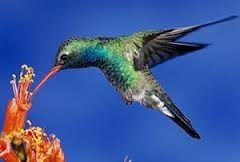Hummingbirds: Magic in the Air
 I watched this Nature documentary for the third time on Wednesday. I plan to use the hummingbird as a metaphor for myself and my search for the truth about my grandmother, so this time I took notes. I also did a three-day training last week in order to make my courses writing intensive; we were encouraged to develop a theme for each class and I’ve decided that my course on black masculinity will now focus on the evolution of black male identity. Sometimes I think I may have missed my calling as a scientist. I used to make “potions” when I was a kid, recklessly blending whatever products I could find under the bathroom sink. I think science stopped being fun in high school—suddenly we were dissecting baby pigs and having to memorize the periodic table. I stuck with environmental science but everything else fell by the wayside. The Hummingbird’s Tongue is an experimental memoir and I plan to include some scientific data about these fascinating birds. Here are some facts about hummingbirds that will amaze you:
I watched this Nature documentary for the third time on Wednesday. I plan to use the hummingbird as a metaphor for myself and my search for the truth about my grandmother, so this time I took notes. I also did a three-day training last week in order to make my courses writing intensive; we were encouraged to develop a theme for each class and I’ve decided that my course on black masculinity will now focus on the evolution of black male identity. Sometimes I think I may have missed my calling as a scientist. I used to make “potions” when I was a kid, recklessly blending whatever products I could find under the bathroom sink. I think science stopped being fun in high school—suddenly we were dissecting baby pigs and having to memorize the periodic table. I stuck with environmental science but everything else fell by the wayside. The Hummingbird’s Tongue is an experimental memoir and I plan to include some scientific data about these fascinating birds. Here are some facts about hummingbirds that will amaze you:
they are the smallest of all warm-blooded creatures
they can hover like insects, which enables them to fly backwards
8000 plant species rely upon hummingbirds for pollination
they can live at high altitudes (12000ft) where no other birds can survive
the species we see in the northeast migrate from Panama and Costa Rica, a round trip journey of 6000 miles
hummingbirds cross the Gulf of Mexico—500 miles of water—in 18 hours
insects comprise one quarter of a hummingbird’s diet
they eat half their body weight in nectar every day, which means they feed at 1000 flowers between dawn and dusk
they have a heart rate of 600bpm when they’re at rest; it’s double that when they’re flying
their wings beats 200x/second
at night they go into a state of torpor, lowering their heart rate to 36bpm which cuts their body temperature in half
there are 350 species of hummingbird and most are endangered





